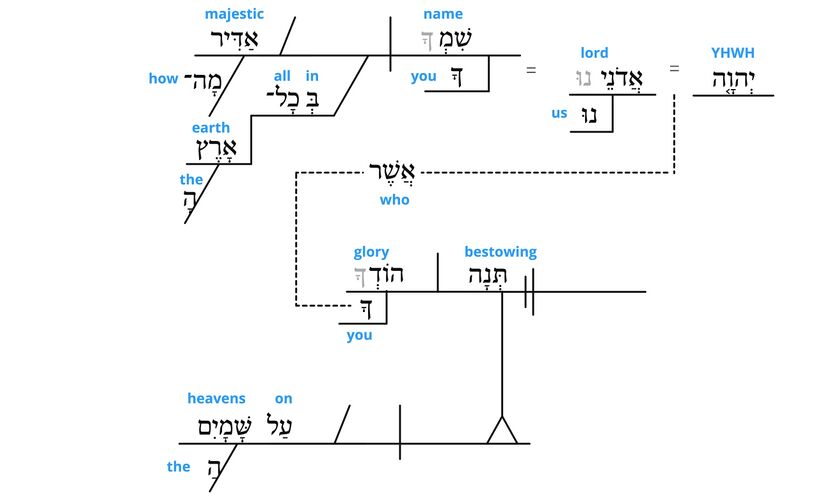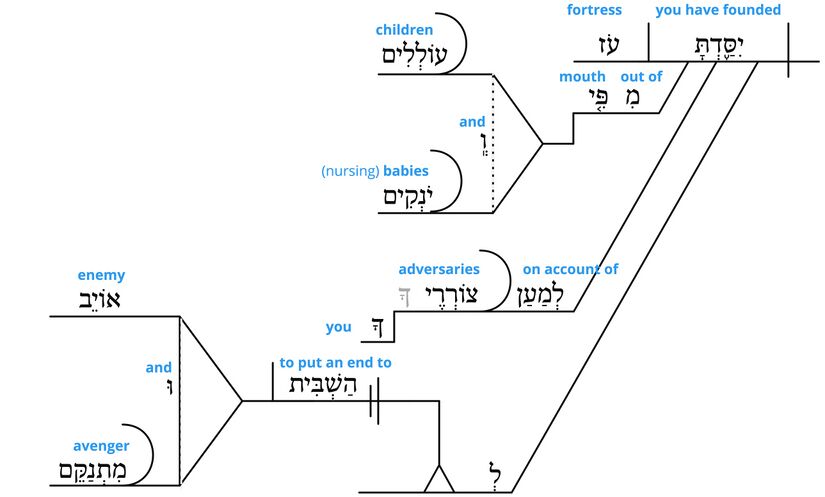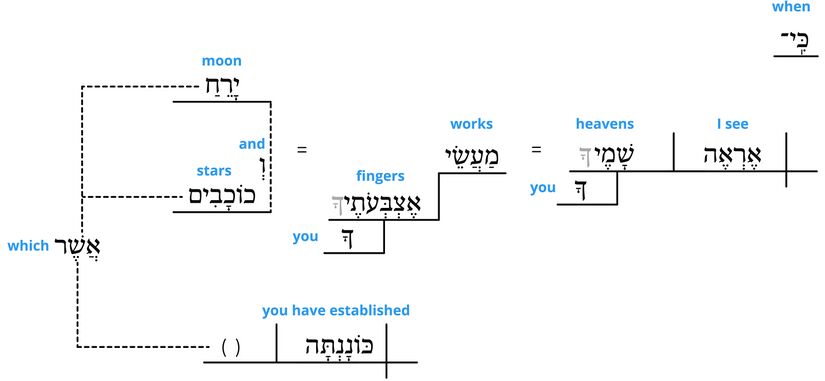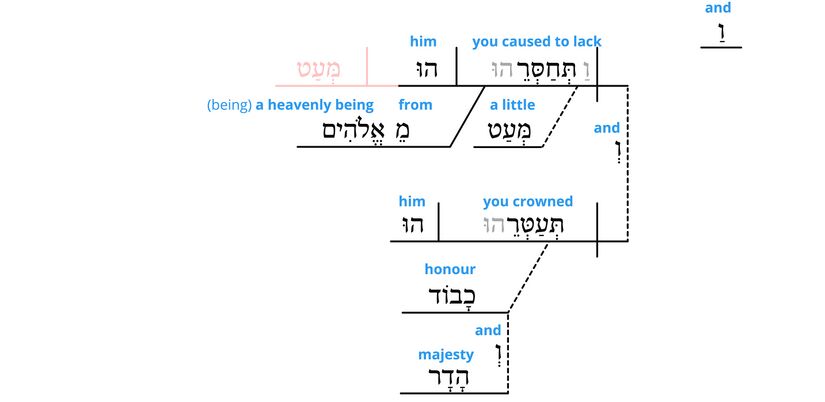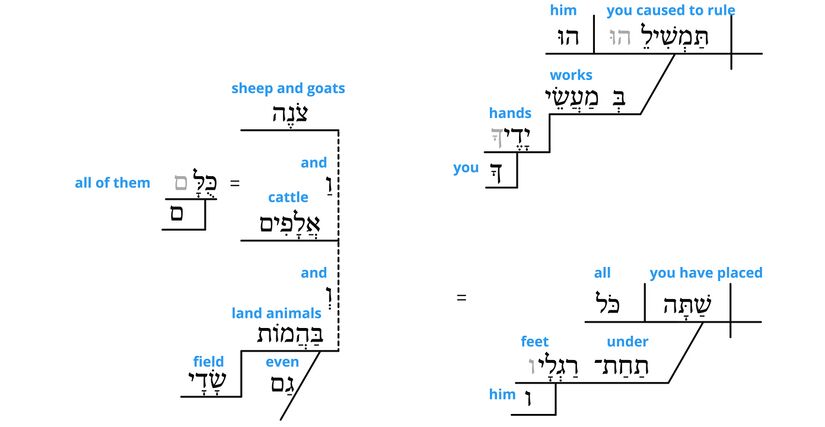Psalm 8 Grammar
From Psalms: Layer by Layer
Back to Psalm 8
Grammatical Diagram
The grammar layer visually represents the grammar and syntax of each clause. It also displays alternative interpretations of the grammar. (For more information, click "Grammar Legend" below.)
| Visualization | Description |
|---|---|
| The clause is represented by a horizontal line with a vertical line crossing through it, separating the subject and the verb. | |
| The object is indicated by a vertical line that does not cross the horizontal line of the clause. Infinitives and participles may also have objects. If the direct object marker (d.o.m.) is present in the text, it appears in the diagram immediately before the object. If the grammar includes a secondary object, the secondary object will appear after the object, separated by another vertical line that does not cross the horizontal line of the clause. | |
| The subject complement follows the verb (often omitted in Hebrew) separated with a line leaning toward the right. It can be a noun, a whole prepositional phrase or an adjective. The later two appear modifying the complement slot. | |
| When a noun further describes or renames the object, it is an object complement. The object complement follows the object separated by a line leaning toward the right. | |
| In a construct chain, the noun in the absolute form modifies the noun in the construct form. | |
| Participles are indicated in whatever position in the clause they are in with a curved line before the participle. Participles can occur as nominal, where they take the place of a noun, predicate, where they take the place of a verb, or attributive, where they modify a noun or a verb similar to adjectives or adverbs. | |
| Infinitives are indicated by two parallel lines before the infinitive that cross the horizontal line. Infinitive constructs can appear as the verb in an embedded clause. Infinitive absolutes typically appear as an adverbial. | |
| The subject of the infinitive often appears in construct to it. In this situation, the infinitive and subject are diagrammed as a construct chain. | |
| The object of the infinitive is indicated by a vertical line that does not cross the horizontal line of the infinitival clause. | |
| Modifiers are represented by a solid diagonal line from the word they modify. They can attach to verbs, adjectives, or nouns. If modifying a verb or adjective, it is an adverb, but if modifying a noun, it is an adjective, a quantifier, or a definite article. If an adverb is modifying a modifier, it is connected to the modifier by a small dashed horizontal line. | |
| Adverbials are indicated by a dashed diagonal line extending to a horizontal line. These are nouns or infinitives that function adverbially (modifying either a verb or a participle), but are not connected by a preposition. | |
| Prepositional phrases are indicated by a solid diagonal line extending to a horizontal line. The preposition is to the left of the diagonal line and the dependent of the preposition is on the horizontal line. They can modify verbs (adverbial) or nouns (adjectival). | |
| Embedded clauses are indicated by a "stand" that looks like an upside-down Y. The stand rests in the grammatical position that the clause fulfills. Extending from the top of the stand is a horizontal line for the clause. If introduced by a complementizer, for example כִּי, the complementizer appears before the stand. Embedded clauses can stand in the place of any noun. | |
| When clauses are joined by a conjunction, they are compound clauses. These clauses are connected by a vertical dotted line. The conjunction is placed next to the dotted line. | |
| Within a clause, if two or more parts of speech are compound, these are represented by angled lines reaching to the two compound elements connected by a solid vertical line. If a conjunction is used, the conjunction appears to the left of the vertical line. Almost all parts of speech can be compound. | |
| Subordinate clauses are indicated by a dashed line coming from the line dividing the subject from the predicate in the independent clause and leading to the horizontal line of the subordinate clause. The subordinating conjunction appears next to the dashed line. | |
| Relative clauses also have a dashed line, but the line connects the antecedent to the horizontal line of the relative clause. The relative particle appears next to the dashed line. | |
| Sentence fragments are represented by a horizontal line with no vertical lines. They are most frequently used in superscriptions to psalms. They are visually similar to discourse particles and vocatives, but most often consist of a noun phrase (that does not refer to a person or people group) or a prepositional phrase. | |
| In the body of the psalm, a horizontal line by itself (with no modifiers or vertical lines) can indicate either a discourse particle or a vocative (if the word is a noun referring to a person or people group). A discourse particle is a conjunction or particle that functions at the discourse level, not at the grammatical level. Vocatives can appear either before or after the clause addressed to them, depending on the word order of the Hebrew. | |
| Apposition is indicated by an equal sign equating the two noun phrases. This can occur with a noun in any function in a sentence. |
| Hebrew text colors | |
|---|---|
| Default preferred text | The default preferred reading is represented by a black line. The text of the MT is represented in bold black text. |
| Dispreferred reading | The dispreferred reading is an alternative interpretation of the grammar, represented by a pink line. The text of the MT is represented in bold pink text, while emendations and revocalizations retain their corresponding colors (see below). |
| Emended text | Emended text, text in which the consonants differ from the consonants of the Masoretic text, is represented by bold blue text, whether that reading is preferred or dispreferred. |
| Revocalized text | Revocalized text, text in which only the vowels differ from the vowels of the Masoretic text, is represented by bold purple text, whether that reading is preferred or dispreferred. |
| (Supplied elided element) | Any element that is elided in the Hebrew text is represented by bold gray text in parentheses. |
| ( ) | The position of a non-supplied elided element is represented by empty black parentheses. For example, this would be used in the place of the noun when an adjective functions substantivally or in the place of the antecedent when a relative clause has an implied antecedent. |
| Gloss text colors | |
|---|---|
| Gloss used in the CBC | The gloss used in the Close-but-Clear translation is represented by bold blue text. |
| Literal gloss >> derived meaning | A gloss that shows the more literal meaning as well as the derived figurative meaning is represented in blue text with arrows pointing towards the more figurative meaning. The gloss used in the CBC will be bolded. |
| Supplied elided element | The gloss for a supplied elided element is represented in bold gray text. |
v. 1
v. 2
- The grammar of this verse is difficult.[1] In terms of morphology, the form תְּנָה looks like an imperative,[2] and this view is "usually accepted."[3] "However, the position of this imperative after אשׁר makes it a syntactically abnormal form."[4] One way around this syntactic issue is to posit an elided quotative frame: "to whom (I say), 'Place your glory on the heavens!'" However, as others have noted, an imperative does not make sense in the context of the psalm, because YHWH's glory is already on the heavens (cf. v. 4).[5]
- For these reasons, many have argued that the form תְּנָה is an infinitive construct.[6] The infinitive construct form of נתן is תֵּת[7] though the form נְתֹן occurs in Num. 20:21 and Gen. 38:9. The anomalous form in Ps. 8 (תְּנָה) finds an analogy in the form מֵרְדָה in Gen. 46:3 (רְדָה instead of רֶדֶת). So Waltke and O'Connor: “The form תְּנָה is not an anomalous imperative of נתן but an infinitive construct, as if formed from the root יתן (the verb 'to give' has this form in Phoenician); compare ירד, infinitive construct רֵדָה.”[8] According to this interpretation, v.2c may be understood as a verbless clause (S: תנה הודך; SC [location]: על השׁמים). “It may be interpreted: 'O Thou whose laying of Thy glory is upon the heavens...' Perhaps the author wrote תּנה הודך instead of נתתּ הודך, because he wishes to describe the setting out of the heavens with divine splendour as being constantly repeated and not as done once for all.”[9] This is the view we have preferred in our diagram.[10]
- Another option is to interpret תְּנָה as a shortened form of נָתְנָה (cf. 2 Sam. 22:41 [תַּתָּה] vs. Ps. 18:41 [נָתַתָּה]). “Aphaeresis of a weak consonant with a full vowel” occurs in other places as well (cf. Jdgs. 19:11; Jer. 42:10; Ezek. 17:5; Hos. 11:3)."[11] In this case, the subject of נתנה (feminine singular) and the antecedent of אשׁר would be הארץ (feminine singular), the final word of the previous line (v.2b).
- Others have argued for emending the text,[12] but none of the proposed emendations has won widespread favour among scholars. It is intrinsically probable that some form of the verb נתן is the original reading: "The attempt of Hitzig, and others, to derive the word from another verb than natan, is refuted alone by the parallel passages, 1 Chron. 24:25, Numb, 27:20, Dan. 11:21, in which natan hod is found exactly as here, with 'al."[13] There is little external evidence for emending the text, since the parent text of the versions is not clear.[14] It is possible that Sym., Hier., Syr., and Tg. interpreted the MT text as an infinitive construct and translated it as a perfect.[15]
- LXX: ὅτι ἐπήρθη ἡ μεγαλοπρέπειά σου ὑπεράνω τῶν οὐρανῶν
- Σ': ος εταξας τον επαινον σου
- Hier: qui posuisti gloriam tuam super caelos
- Tg.: דיהבתא זיוך עיל מן שמיא׃
- Syr.: ܕܝܗܒܬ ܫܘܒܚܟ ܥܠ ܫܡܝܐ܂
v. 3
v. 4
v. 5
v. 6
- The morphologically stative verb חסר in the qal stem can be transitive ("to lack something") or intransitive (a: "to be lacking" or b: to diminish [only in Gen. 8:3, 5 according to BDB and DCH]). When the subject is a person or persons, the verb is always transitive (Gen. 18:28; Deut. 2:7; 8:9; 1Kgs 11:22; Jer. 44:18; Ezek. 4:17; Ps. 32:11; Prov. 31:11), though a direct object is not grammatically required in every instance (e.g., Ps. 23:1). When the subject is a thing (usually a material good), the verb is usually intransitive (1 Kgs 17:14, 16 [jar of oil]; Isa. 51:14 [bread]; Eccl. 9:8 [oil]; 10:3 [sense]; Song 7:3 [wine]; cf. Gen. 8:3, 5 [water]). In Ps. 8:6, the experiencer of the state חסר is a person (humanity). Therefore, the verb (in the piel stem)[16] means "to cause to lack," not "to cause to be lacking" or "to cause to be less."
- In Ps. 8:6, that which is lacked is either indicated by the noun מעט, so that the verb is ditransitive: "cause him to lack a little bit"[17] or by the min prepositional phrase (מאלהים), as in Eccl. 4:8. In the first case, מעט would be a second object on the mainline of the grammatical diagram ("you caused him to lack a little"). However, מעט can also function adverbially.[18] This seems more likely in light of Eccl. 4:8 (the only other instance of חסר in the piel stem), where חסר ("cause to be lacking") takes only one object (my soul) and the thing which is lacked is syntactically encoded not as a second object but as a min prepositional phrase (מטובה). As Delitzsch explains in his commentary on Psalm 8, "חסר מן signifies to cause one to be deficient in something, so that it is wanting to him (Eccles. 4:8). מן is neither comparative (paullo inferiorem ewm fecisti Deo) nor partitive (paullum derogasti ei divine naturae), but, seeing that אלהים is never used in an abstract manner so as to be equivalent to divine essentiality, negative (paullum derogasti ei ne esset Deus), so that אלהים is equivalent to מהיות אלהים, cf. 31 in 1 Sam. 15:23, מעם in Isa. 7:8."[19] So also BDB 583.7b(b).
v. 7-8
v. 9
v. 10
Full diagram (vv. 1-10)
For Visual, click "Expand" to the right
References
- ↑ See the discussion in HALOT (1761, תנה) for an overview of the interpretive options.
- ↑ GKC §66h
- ↑ HALOT 1761, תנה.
- ↑ Barthélemy; cf. Baethgen: Ein Imperativ ist jedoch im Relativsatz unmöglic; Gunkel: "aber das ist im Zusammenhang völlig unmöglich (29). For this reason, some commentators (e.g., Briggs) consider the relative particle a secondary addition to the text.
- ↑ Hupfeld, Baethgen
- ↑ E.g., Radak, Calvin, Delitzsch, Ewald, Hengstenberg, Barthélemy, et. al.
- ↑ GKC §66h; JM §72i; BHRG §18.11.3.
- ↑ IBHS, §11.2.13b [note 105]
- ↑ Delitzsch.
- ↑ Hupfeld (pp. 149-153) argued against this view, noting that 1) an infinitive construct ending in -ah for a 1-nun verb is unheard of, and 2) that תנה is the usual imperatival form. The word therefore cannot be understood as anything other than an imperative. And, since this is syntactically impossible here, the text must be emended.
- ↑ GKC §19i. “In reality, however, all these forms are to be regarded merely as old textual errors” (GKC §19i).
- ↑ See HALOT (1761, תנה) for a list of several proposed emendations.
- ↑ Hengstenberg. The most likely emendation is that proposed by Hupfeld et. al: נָתַתָּ
- ↑ Barthélemy
- ↑ Baethgen.
- ↑ The piel stem of verbs that are morphologically stative (like חסר) are usually factitive (i.e., the object of the verb is placed into the state indicated by the verb in the qal). "For such verbs, the Piel is an accreting stem or transitivizer, adding a core argument..." (Steven Boyd, "The Binyanim," in Where Shall Wisdom Be Found, 2017:101).
- ↑ GKC 117cc; Hupfeld 1853:160f.
- ↑ See DCH מעט, sections 1bc. DCH lists Ps. 8:6 as an adverbial use of מעט.
- ↑ Delitzsch 1883:196f.





















